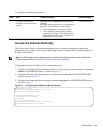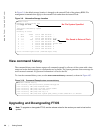
Getting Started | 53
View Files
File information and content can only be viewed on local file systems.
Task Command Syntax Command Mode
Save the running-configuration to:
EXEC Privilege
the startup-configuration on the
internal flash of the primary RPM
copy running-config startup-config
the internal flash on an RPM copy running-config rpm{0|1}flash://filename
Note: The internal flash memories on the RPMs are synchronized whenever there
is a change, but only if the RPMs are running the same version of FTOS.
Note: FTOS supports IPv4 and IPv6 addressing for FTP, TFTP, and SCP (in the
hostip field).
the external flash of an RPM copy running-config rpm{0|1}slot0://filename
an FTP server
copy running-config ftp://
username:password
@{hostip | hostname}/filepath/
filename
a TFTP server copy running-config tftp://{hostip | hostname}/
filepath/filename
an SCP server copy running-config scp://{hostip | hostname}/
filepath/filename
Note: When copying to a server, a hostname can only be used if a DNS server is configured.
Save the running-configuration to the
startup-configuration on the internal flash
of the primary RPM. Then copy the new
startup-config file to the external flash of
the primary RPM.
copy running-config startup-config duplicate
EXEC Privilege
FTOS Behavior: If you create a startup-configuration on an RPM and then move the RPM to another
chassis, the startup-configuration is stored as a backup file (with the extension .bak), and a new,
empty startup-configuration file is created. To restore your original startup-configuration in this
situation, overwrite the new startup-configuration with the original one using the command copy
startup-config.bak startup-config.


















